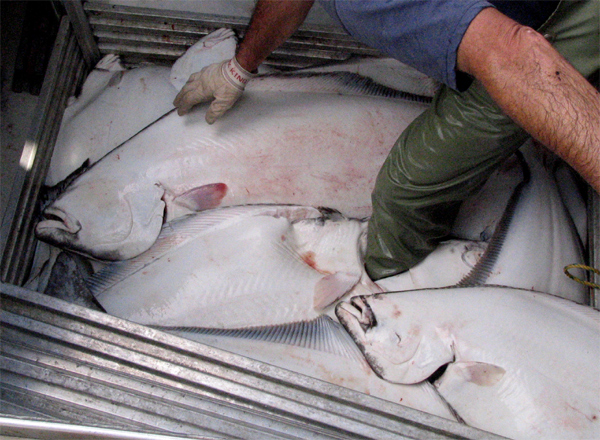Maine Seafood Guide – Halibut

Season
Status
Regulatory Authority
Harvest Method
Recreational Harvest
Health Benefits & Risks
Buying & Preparing
Brands
Certifications
Links
►Species Description
Atlantic halibut Hypoglossus hypoglossus
Wild, although small quantities of halibut are cultured by Maine Halibut Farms.
The Atlantic halibut is a large, bottom-dwelling flatfish that ranges from Labrador to southern New England. Learn more about the history of halibut fishing from the Downeast Fisheries Trail.
►Season
In Maine territorial waters, from sunrise on May 18 to sunset June 13.
►Status
The coast-wide population of Atlantic halibut is overfished, but overfishing is no longer occurring and the stock is subject to a long-term rebuilding plan.
►Regulatory Authority
Maine Department of Marine Resources regulates harvest in state waters (within three miles of shore). Gulf of Maine halibut are managed by the New England Fishery Management Council under the Northeast Multispecies (groundfish) Plan.
►Harvest Method
Trawl, hook and line. In state waters, halibut may only be targeted with circle hooks. Longline or tub trawl is preferred catch method. See the vessel and gear guide for more information.
►Recreational Harvest
Maine Territorial Waters:
Minimum size limit of 41 inches and a yearly vessel limit of five fish per year during season
Season: Sunrise on May 18 – sunset June 13
Anglers must use only 14/0, 15/0, or 16/0 circle hooks; recreational tags required.
All retained fish shall immediately be tagged with an approved landings tag to help DMR track the population; call 207-624-6550 for more information.
Federal:
Halibut can be fished year-round in federal waters, with a limit of one fish per day, a total of five fish per year.
►Health Benefits & Risks
Halibut is a low-fat, low-calorie source of selenium and vitamin D, but is lower in omega-3 fatty acids than other fish. Mercury levels vary in halibut, depending on fish size and age, but are generally below safety limits.
►Buying & Preparing
In Maine, groundfish are landed primarily at the Portland Fish Exchange and then distributed to local seafood markets. A few cooperatives are emerging that sell local halibut directly to consumers, such as Port Clyde Fresh Catch. As with other finfish, look for firm flesh, a fresh non-fishy smell, and clear eyes if buying whole. “Local” halibut is only available in May and June; during the rest of the year, halibut comes from the groundfishery in federal waters (> three miles offshore).
►Companies, Brands, and Labels
►Certifications & Verifications
►Links
- Halibut information from Maine Department of Marine Resources
- NOAA Fisheries Species Directory
